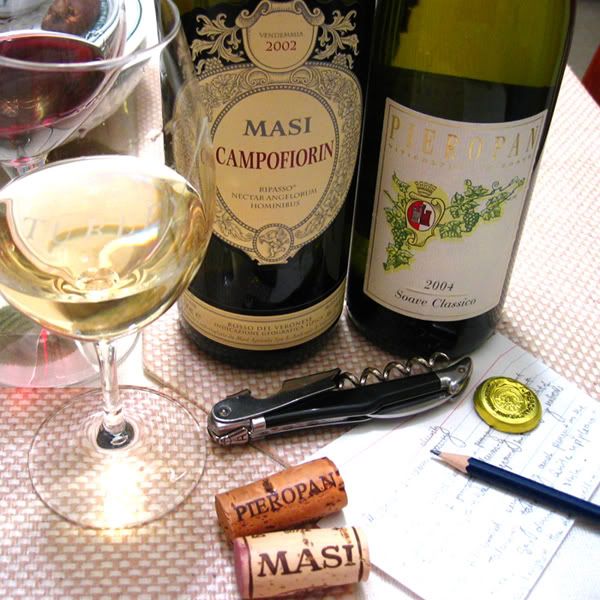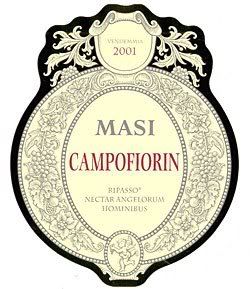 2004 Pieropan Soave Classico, Veneto, Tre Venezie, Italy
2004 Pieropan Soave Classico, Veneto, Tre Venezie, ItalyGolden yellow with a touch of orange. Aroma of banana, chrysanthemum/white flower, tangerine, and a hint of sweet pandan leaf. Light bodied and flat from lack of acidity. Mellow, round and goes down quite buttery. Short finish that reminds me of citrus and grapefruit, but it lacks the oomph to clearly define its citrussy characters. Not especially interesting.
2 stars (so-so) Note: This was my first soave experience. Perhaps I'm not understanding how a soave ideally supposed to taste like. I just prefer a white with more zing.
 Amid a sea of dull Soave coming out of the Veneto region, Pieropan, which is a small family-owned winery in Verona is an exception and the standard bearer for making elegant and classy Soave. This vintage and this bottling, however, is not showing its class as it's supposed to. I am not about to give up hope with this winery, as I am interested in finding out the meaning of good Soave from their other bottlings and vintages.
Amid a sea of dull Soave coming out of the Veneto region, Pieropan, which is a small family-owned winery in Verona is an exception and the standard bearer for making elegant and classy Soave. This vintage and this bottling, however, is not showing its class as it's supposed to. I am not about to give up hope with this winery, as I am interested in finding out the meaning of good Soave from their other bottlings and vintages.Read more about the Pieropan winery at the Winedoctor's website.
2002 Masi Campofiorin Ripasso, Veneto, Tre Venezie, Italy
Medium purple / garnet. I poured a glass and placed the rest in a decanter. First glass: a whiff of band-aid (brett?), funky aroma, barnyard and a slight talcum smell. Pungent. A bit of cherries in the background? Medium - full bodied. Quite gamey and pungent in the mouth. Fine dusty tannin. This bottling is such a stark contrast to the wonderful previous Campofiorin vintages I've had. I've always liked Campofiorin as a wine that gives more than it costs, but this bottling makes a Charles Shaw wine seems charming. I poured the first glass down the sink. It remains to be seen how it tastes after being decanted.
No star (poor) Note: this is an exception to the usual. Masi Campofiorin has always consistently been one of my favorite affordable Italian wines.
After 5 hours in a decanter:
All the funky and unpleasant aromas have disappeared! This wine has transformed into a floral one: violet and orange peel comes to mind, with a bit of lavender, I suppose. Tannin seems to be coarser than before, though. The wine has become slightly more acidic and oxidized. Light coffee-ish aftertaste, short finish. Still disappointing.
1 star
After 12 hours in a decanter:
Somehow it turned into a mulchy, stewy prunes / plums and stewy strawberries. The wine has turned sour (oxidized). Down the sink it all went.
About Masi Campofiorin1
"Campofiorin is the name of a vineyard in the Marano Valley of Italy's Veneto region, near Verona; the wine comes from this vineyard and neighboring vineyards that share its soil and climate. This vineyard once made a wine called "Campo Fiorin" Amarone, in the days before Amarone became a restricted DOC name.
 In recent vintages, Campofiorin wine has become, technically, an IGT wine because, according to Sandro Boscaini of Masi, the available DOC designation, Valpolicella, is too generic, encompassing wines of divergent quality, production method and price. But Campofiorin is a product of the Valpolicella zone, made from traditional local grapes, about 70 percent Corvina and the remainder Molinara and Rondinella.
In recent vintages, Campofiorin wine has become, technically, an IGT wine because, according to Sandro Boscaini of Masi, the available DOC designation, Valpolicella, is too generic, encompassing wines of divergent quality, production method and price. But Campofiorin is a product of the Valpolicella zone, made from traditional local grapes, about 70 percent Corvina and the remainder Molinara and Rondinella.Campofiorin is the original ripasso, a term that Masi invented and trademarked. And Masi's modern variation of that winemaking process is what accounts for the wine's unique expression.
Ripasso refers to a traditional local process of re-fermenting a dry Valpolicella wine by adding the sugar-rich skins that remain from the fermentation of Amarone (which, being made from dried grapes, ferments a few months later than Valpolicella and other wines made from fresh grapes). The double fermentation increases the body and tannins of the wine. Today, the ripasso of Campofiorin involves crushing and fermenting about 70 percent of the wine's grapes when they are fresh; the remaining grapes are semi-dried for several weeks before being employed to instigate another fermentation in the main wine. Boscaini describes the result as a wine that 'combines the complexity and spiciness of Amarone with the crispness, freshness and conviviality of Valpolicella.'"
1 Quoted from winereviewonline.com, written by Mary Ewing-Mulligan, December 6, 2005
No comments:
Post a Comment